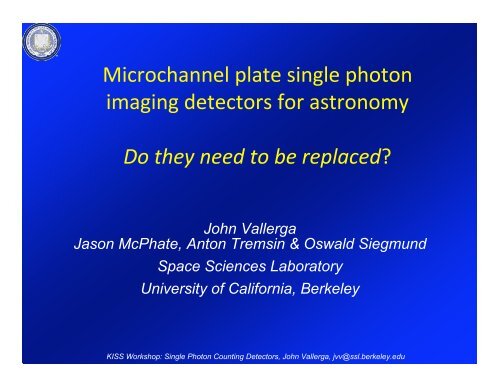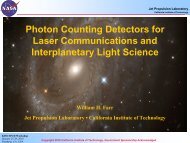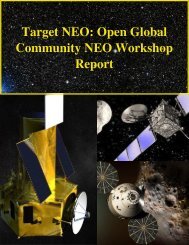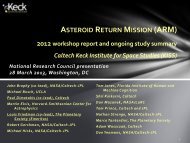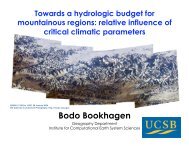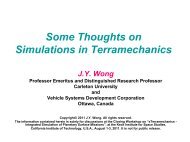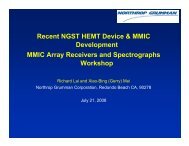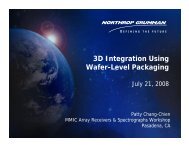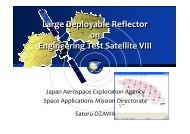Microchannel plate single photon imaging detectors for astronomy ...
Microchannel plate single photon imaging detectors for astronomy ...
Microchannel plate single photon imaging detectors for astronomy ...
- No tags were found...
Create successful ePaper yourself
Turn your PDF publications into a flip-book with our unique Google optimized e-Paper software.
<strong>Microchannel</strong><strong>plate</strong><strong>single</strong><strong>photon</strong><strong>imaging</strong><strong>detectors</strong><strong>for</strong><strong>astronomy</strong>Dotheyneedtobereplaced?John VallergaJason McPhate, Anton Tremsin & Oswald SiegmundSpace Sciences LaboratoryUniversity of Cali<strong>for</strong>nia, BerkeleyKISS Workshop: Single Photon Counting Detectors, John Vallerga, jvv@ssl.berkeley.edu
<strong>Microchannel</strong> Plateelectron amplifier that retains position in<strong>for</strong>mationPore size ~ 2 to 40µmGain ~ 10 to 10 8Time Jitter ~ 30 psKISS Workshop: Single Photon Counting Detectors, John Vallerga, jvv@ssl.berkeley.edu
<strong>Microchannel</strong> Plate DetectorPhoton counting, <strong>imaging</strong>, with event time tagging• Photocathode converts<strong>photon</strong> to electron!• MCP(s) amplifyelectron by 10 4 to 10 7Tube Window withphotocathode• Rear field accelerateselectrons to anodeMCPstack• Patterned anodemeasures chargecentroidCharge distribution on stripsCharge CloudKISS Workshop: Single Photon Counting Detectors, John Vallerga, jvv@ssl.berkeley.edu
MCP Detectors at SSL BerkeleyCOS FUV <strong>for</strong> Hubble (200 x 10 mm windowless)18 mm Optical TubeGALEX68 mm NUVTube200+ “detector years” inspace including mission toPlutoKISS Workshop: Single Photon Counting Detectors, John Vallerga, jvv@ssl.berkeley.edu
<strong>Microchannel</strong> Plate Sensor Applications530 DF 30615 DF 45500 LPM1010 20 40 60 80 100 120 140 160 180Time [ns]Fluorescent dye decay timeBiological lifetime fluorescence <strong>imaging</strong> (UCLA)UV Astronomy (GALEX)Low Light Ladar - 3D <strong>imaging</strong>High time resolution AstronomyPonderosa Pine 3D data cube - RULLI, LANL33ms period, 250µs resolution1m Lick observatory telescopeKISS Workshop: Single Photon Counting Detectors, John Vallerga, jvv@ssl.berkeley.edu
High Speed Imaging AstronomyCrab Pulsar B band light curve(1 m telescope on Moonlit night)KISS Workshop: Single Photon Counting Detectors, John Vallerga, jvv@ssl.berkeley.edu
Meteor & Satellite DetectionMeteor track in AH-Her field5 ms to cross 6’ FOV.~11 km/sec if at 30 km2 ms time framesKISS Workshop: Single Photon Counting Detectors, John Vallerga, jvv@ssl.berkeley.edu
Meteor & Satellite DetectionSatellite track in FL-Vir field~8.5 km/sec in low earth orbit5 ms framesKISS Workshop: Single Photon Counting Detectors, John Vallerga, jvv@ssl.berkeley.edu
Photon Counting MCP DetectorsAdvantagesSpatial resolutionTemporal resolutionFormat< 12µm FWHM< 100 ps> 100 mmDynamic range > 10 8Radiation hardCurved focal planesRoom TemperatureDisadvantagesVacuum operationpumps, tubes or spaceLifetime ~ Coulombs cm -2Photoelectric QE ~ 50% to 10 -12KISS Workshop: Single Photon Counting Detectors, John Vallerga, jvv@ssl.berkeley.edu
Per<strong>for</strong>mance examplesPhotocathode QETemporal resolutionGaNGaAsSuperGenIIS20Photocathode types <strong>for</strong> UV, visible& NIR are improving.MCP timing jitter ~100 ps FWHMmeasured with pulsed laserKISS Workshop: Single Photon Counting Detectors, John Vallerga, jvv@ssl.berkeley.edu
Readout Anode Types (partial list)Cross Delayline(XDL)4 ampsGain ~ 10 7Rate ~ 200kHzΔt ~ 100psCross Strip(XS)2 x N ampsGain ~ 10 6Rate ~ 2MHzΔt ~ 100psMedipix ASICIntensified CCDN x N ampsGain ~ 10 4Rate ~ 200MHzΔt ~ 1 msKISS Workshop: Single Photon Counting Detectors, John Vallerga, jvv@ssl.berkeley.edu
Cross Strip Anode Designs22mm round cross strip45mm square Cross Strip Anodewith 0.64 mm finger period. All metaland ceramic.22mm round cross stripshowing vias and connectorKISS Workshop: Single Photon Counting Detectors, John Vallerga, jvv@ssl.berkeley.edu
Imaging tests - resolutionZoomed - 20 µm FWHM avg.40 mm - 0.5 x 0.5 mm pinhole gridKISS Workshop: Single Photon Counting Detectors, John Vallerga, jvv@ssl.berkeley.edu
Medipix/Timepix x-ray imagerKISS Workshop: Single Photon Counting Detectors, John Vallerga, jvv@ssl.berkeley.edu
Medipix/Timepix ASIC readout• 256 x 256 array of 55 µm pixels• Integrates counts, not charge• 100 kHz/pxl• Frame rate: 1 kHz• Low noise (100e - ) = low gainoperation (2 ke - )• GHz global count rate• ~1 W watt/chip, abuttable~ 500 transistors/pixel• Developed at CERNKISS Workshop: Single Photon Counting Detectors, John Vallerga, jvv@ssl.berkeley.edu
Aside: Timepix readout of APD arrays?Require gains of > 1000 but < 200000Input pitch is 55µm256 x 256 arrayCan cool CMOS chip to 77K(but 1W per chip is a high load)Cannot bias pixels separatelyInput takes holes or electrons,(can sink up to 10nA/pxl)KISS Workshop: Single Photon Counting Detectors, John Vallerga, jvv@ssl.berkeley.edu
Old WWII watch movie66 MHz input rateKISS Workshop: Single Photon Counting Detectors, John Vallerga, jvv@ssl.berkeley.edu
Old WWII watch movie 2Bkgd.002 ct/pxl/sRoom Temp(radium dial)KISS Workshop: Single Photon Counting Detectors, John Vallerga, jvv@ssl.berkeley.edu
MCP pores (10 on 12 micron)KISS Workshop: Single Photon Counting Detectors, John Vallerga, jvv@ssl.berkeley.edu
Evolution of MCP <strong>detectors</strong>1985 2010 ImprovementCount rate (cps) 5000 5x10 6 1000Spatial Resolution (µm) 100 10 10Lifetime (cts/mm) 10 9 10 12 1000Optical QE (%) ~15 ~30 2Limited by MCP technology!Size (mm) 100 100 1Pore diameter (µm) 12 6 2Lifetime (C/mm) .01 .01 1KISS Workshop: Single Photon Counting Detectors, John Vallerga, jvv@ssl.berkeley.edu
Atomic layer deposition (ALD)Allows engineering of surfaces after MCPpores are fabricated– Optimize secondary electron coefficient <strong>for</strong> gain– Optimize resistivitySeparates microchannel fabrication fromsurface preparation– MCPs can be made from any glass, alumina, plastic– Lithographic techniques <strong>for</strong> larger arrays of poresPhotocathodes deposited on MCP(?)– Passivated (Al 2 O 3 ) surfaces– Higher QE of opaque photocathodesKISS Workshop: Single Photon Counting Detectors, John Vallerga, jvv@ssl.berkeley.edu
Borosilicate glass MCP33 mm substrate from INCOMResistive, SEC, and conductivecoatings by ArradianceMicroscope image showing40 µm holes in hexagonalarray with L/d ratio of 40KISS Workshop: Single Photon Counting Detectors, John Vallerga, jvv@ssl.berkeley.edu
Results from ALD coated Incom glassALD coating done byArradiance Inc.(www.arradiance.com)KISS Workshop: Single Photon Counting Detectors, John Vallerga, jvv@ssl.berkeley.edu
SSL-UCB, ALD/Incom MCP TestIt works!700v800vBright scratchon phosphorUV light1000v900vKISS Workshop: Single Photon Counting Detectors, John Vallerga, jvv@ssl.berkeley.edu
Psec Timing Project(P.I Henry Frisch, U. Chicago, Argonne)Large area (8”x8”) MCP image tubes <strong>for</strong>Cherenkov arrays and PET <strong>detectors</strong>Delayline readout, specialized ASICsPulse timing to 1 ps (mulitple <strong>photon</strong>)Thousands of tubesInexpensive designKISS Workshop: Single Photon Counting Detectors, John Vallerga, jvv@ssl.berkeley.edu
8 inch image tubeKISS Workshop: Single Photon Counting Detectors, John Vallerga, jvv@ssl.berkeley.edu
Concluding RemarksMCP <strong>detectors</strong> “in the field” demonstrate what can bedone with an <strong>imaging</strong> <strong>photon</strong> counting <strong>detectors</strong>.They are prevalent in the UV because of their historicalQE advantage.Modern electronic techniques are expanding their nicheapplicationsNew developments in optical/near IR photocathodes arepushing this technology to longer wavelengths.Other know weaknesses (lifetime, cost, etc.) are beingaddressed with new materials and methods.There is still life in this old war-horse!KISS Workshop: Single Photon Counting Detectors, John Vallerga, jvv@ssl.berkeley.edu
Thank YouI would like to acknowledge the support of theNational Science FoundationNational Institutes of HealthNational Institutes of Standards and TechnologyNational Aeronautics and Space Administrationunder various contract and grant numbers.KISS Workshop: Single Photon Counting Detectors, John Vallerga, jvv@ssl.berkeley.edu


